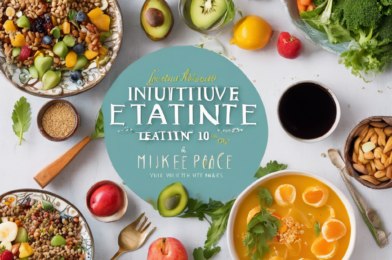Our gut is integral to our overall health and well-being, often referred to as our “second brain.” It influences not just our digestion but also our mood, energy levels, and immune function. With the myriad of modern-day stressors and less-than-ideal dietary choices, it’s no surprise that many people are seeking ways to reset and optimize their gut health. That’s where the concept of a 7-day gut health reset comes into play, offering a focused approach to revitalizing your body from the inside out.
During this 7-day reset, the primary focus is on providing your gut with the support it needs to function optimally. This involves a period of dietary restriction, followed by a gradual reintroduction of foods, allowing you to identify any potential triggers or intolerances. The idea isn’t to stick to restrictive diets long-term but to use this as a tool to reset your gut, improve digestion, and enhance overall health. By simplifying your diet, you reduce the burden on your digestive system, giving it a chance to heal and recover.
So, what does this reset entail? Typically, it involves eliminating common irritants and inflammatory foods such as gluten, dairy, added sugars, alcohol, and highly processed foods. Instead, you’ll be focusing on whole, natural foods, including plenty of fiber-rich fruits and vegetables, lean proteins, healthy fats, and, most importantly, a diverse array of plant-based foods to feed your gut microbes. Additionally, staying hydrated and incorporating natural probiotics, such as yogurt or kefir, can further support the growth of beneficial bacteria in your gut.
One of the critical aspects of this reset is paying attention to how your body responds as you gradually reintroduce different food groups. This helps identify any sensitivities or intolerances that may have been masked before. For example, you might find that gluten or dairy triggers bloating or discomfort, indicating that reducing or eliminating these foods long-term could be beneficial for your gut health. Everyone’s experience will be unique, and this reset is an opportunity to gather valuable insights into your body’s specific needs.
The benefits of a gut health reset can extend far beyond improved digestion. A well-functioning gut contributes to better nutrient absorption, enhanced immune function, improved mental clarity, stable energy levels, and a healthier microbial balance. By taking this focused approach, you are empowering yourself with the knowledge to make informed dietary choices that support your gut and overall health. Remember, this isn’t about perfection or deprivation; it’s about giving your gut the love and attention it deserves to thrive.
As you embark on this 7-day journey, it’s important to listen to your body and adjust as needed. Some people may find they tolerate certain foods better than others, so customization is key. Support your reset with adequate sleep, stress management, and light to moderate exercise, all of which contribute to a healthier gut. By incorporating these practices, you’re not just resetting your gut; you’re establishing a foundation for long-term health and well-being.
While the dietary aspect is central to this reset, it’s also worth noting that other lifestyle factors play a significant role in gut health. Chewing your food thoroughly, eating in a relaxed state, and practicing mindful eating can all contribute to better digestion. Additionally, managing stress through techniques like deep breathing, meditation, or gentle exercise can further support your gut health journey, as chronic stress can negatively impact digestion and the balance of bacteria in your gut.
On top of dietary adjustments, incorporating gut-friendly beverages can further support your reset. Drinking bone broth, for instance, provides essential amino acids and nutrients that support gut integrity and reduce inflammation. Herbal teas, particularly those containing ginger, peppermint, or fennel, can aid digestion and soothe the gut. Kombucha, a fermented tea, offers a natural source of probiotics, contributing to a healthier gut microbiome. Drinking ample water is also key, as it aids digestion and ensures your gut has the fluid it needs to function optimally.
When it comes to mealtimes during your gut health reset, focus on simplicity and whole foods. That might mean a breakfast of scrambled eggs with vegetables, a side of avocado, and a piece of gluten-free toast. Lunch could be a hearty salad with leafy greens, roasted vegetables, nuts or seeds, and a dressing made with olive oil and vinegar. For dinner, a lean protein source like grilled chicken or baked fish, along with steamed or roasted vegetables and a small portion of whole grains, such as quinoa or brown rice, can be a tasty and nourishing option.
While snacks are often seen as indulgent treats, they can play an important role in a gut-healthy diet. Choosing gut-friendly snacks that combine protein and fiber can help stabilize blood sugar levels and reduce cravings. Some tasty options include hummus with vegetable crudités, a handful of almonds or other nuts, a piece of fruit with a small handful of nuts, a hard-boiled egg, or a yogurt with berries. Smoothies made with a blend of fruit, vegetables, and a healthy fat source, such as avocado or nut butter, can also be a convenient and nourishing snack option.
As you navigate your 7-day gut health reset, it’s important to keep in mind that this is a journey of self-discovery. Everyone’s gut is unique, and paying attention to your body’s responses will guide you toward making the best long-term choices for your health. Some people may find that certain food groups, like gluten or dairy, are better avoided, while others may tolerate them in moderation. There is no one-size-fits-all approach, and respecting your body’s individual needs is key to success. Embrace the process of discovery and use it as a foundation for sustainable, gut-healthy habits.
In addition to dietary changes, incorporating gut-friendly supplements can further enhance your reset experience. Probiotic supplements, containing beneficial bacteria, can help restore a healthy balance to your gut microbiome, supporting digestion and immune function. Prebiotic supplements, which provide food for the good bacteria in your gut, can also be beneficial. However, it’s important to consult with a healthcare professional before starting any new supplements to ensure they’re right for your individual needs.
While the 7-day gut health reset is a focused and intensive approach, it’s important to view it as a starting point rather than a quick fix. The insights and habits gained during this time can set you up for long-term success, but they require ongoing commitment and maintenance. That might mean continuing to incorporate gut-friendly foods, staying hydrated, managing stress, and getting quality sleep. By adopting a holistic approach to your health, you’re more likely to maintain the benefits gained during the reset and experience improved gut health and overall well-being for the long haul.









